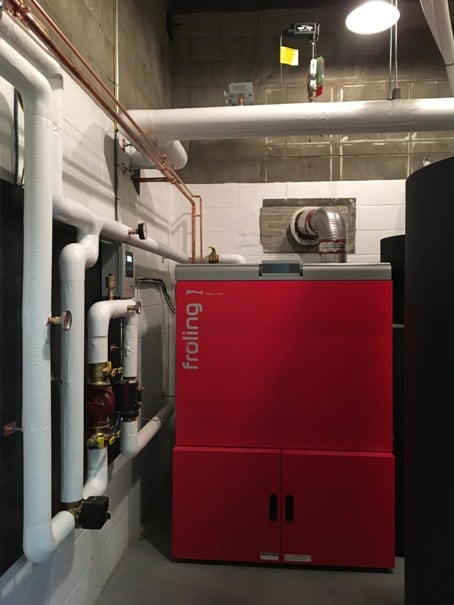A Fertile Opportunity for Renewable Heating
Sometimes nice old buildings present fertile opportunities for renewable heating makeovers with Fröling wood pellet boilers. Here is a great example. The 30,000 square foot office and warehouse was built starting in 1965 by New Hampshire Governor Meldrim Thomson for his Equity Publishing business. As Governor Thomson's business grew from the core 1965 building, each building addition received another heating system. When Tarm Biomass moved into the building almost 2 decades after the Thomson Family owned it, there were 6 separate heating systems.



Original Equipment
The original, blackened, American Standard oil boiler with its 6 inch stalactite pipe leaks remained in place. Three propane fired rooftop units redundantly heating office space also heated by the oil boiler. An oil-fired furnace array hung from the ceiling of 1986 high cube warehouse. There was also an oil furnace, we'll call it Frankenstein, heating another 10,000 square feet. Based on oil stains and soot coatings, Frankenstein appeared to be at least 40 years old.


Tarm Biomass Moves In
With Tarm Biomass as a tenant, the new building owners saw an opportunity. They hired Tarm Biomass to update and simplify the heating system. The new renewable heating system would use Fröling Wood Pellet Boilers. With winter fast approaching in 2016, Tarm Biomass began a thermal makeover. Tarm Biomass started by breaking the old American Standard cast-iron sections apart and carting the soot and mud-filled beasts to the scrap heap. Tarm Biomass then built a new distribution manifold and installed a Viessmann propane boiler where the oil boiler had been. While serving as the primary heating source in the winter of 2016/2017, the propane boiler became a backup heat source for the future.
Where the Frankenstein furnace once lived, two new wood pellet boilers, 350,000 Btu/hr each, were added. A 1,250-gallon buffer tank was installed in the adjacent warehouse. The boiler installation space was chosen due to its proximity to an outside wall, allowing pellet delivery truck access and a simple chimney installation. A 15-ton pellet silo was placed just outside the new boiler room. The Fröling wood pellet boilers pneumatically pull fuel through 2" hoses from the silo as needed, which makes it unnecessary for building staff to ever handle the fuel.
Fröling Wood Pellet Boilers and Expert Installation Create a Fresh Start




The Fröling Wood Pellet Boilers work automatically in a cascade to heat the buffer tank. Consequently, as the buffer tank drops in temperature, each boiler responds as needed to keep the tank hot. There is a Grundfos Magna circulator that automatically responds to building demand by measuring the difference in supply and return temperature. When there is a call for heat, the Magna pushes heat to the building load automatically. Through flow modulation, the Grundfos Magna not only saves power but also helps the buffer tank store thermal energy more effectively. Replacing the Frankenstein furnace with 2 new air handlers connected to the Fröling wood pellet boilers was easy. Now, approximately 20,000 square feet are heated with wood pellets.
Renewable Energy Funding Opportunities
Using wood pellets presented several opportunities. First and foremost, the State of New Hampshire, through the Renewable Energy Division of the Public Utilities Commission, provided a generous, 40% rebate payment of just over $58,000. The United States Department of Agriculture also helped with a Rural Energy for America (REAP) grant of around $20,000.
Thermal Renewable Energy Credits
Lastly, until at least 2025, the building owners will be able to sell thermal renewable energy credits (T-RECs). T-RECs are marketable commodities that are worth about $22.50 per megawatt-hour. T-RECs are created by New Hampshire law, which requires power generators to produce a certain amount of energy with renewable sources. If generators cannot produce their own renewable energy, they must purchase renewable energy credits. A certain amount of those credits must be purchased from the thermal class of available credits.
Tarm Biomass installed a heat meter, tallying energy produced by the pellet boilers and uploading that data to a website. The output data is verified by a qualified third-party auditor. Though the final quarter of 2017 was a warm period, the building owners generated 20-megawatt hours of thermal energy, which was worth about $450.00 after paying a fee to a T-REC aggregator. Based on fuel use predictions, the building owners expect to earn between $2,000 and $3,000 each year selling T-RECs. Each ton of wood pellets generates approximately four T-RECs in efficient pellet boilers.
During the winter of 2017/2018 locally made wood pellet heat offset about 6,000 gallons of propane use. It seems that there is excess wood pellet boiler heating capacity. With that in mind, the building owners are already exploring extending heat from the wood pellet boiler system to the last remaining 10,000 square foot oil heated space. Stay tuned for follow-up stories about fuel use and savings.


